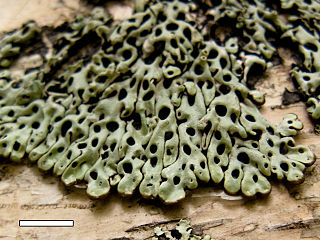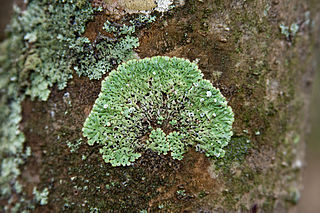
Menegazzia is a genus of lichenized fungi containing roughly 70 accepted species. The group is sometimes referred to as the tree flutes, honeycombed lichens, or hole-punch lichens. The most obvious morphological feature of the genus is the distinctive perforations spread across the upper side of the thallus. This makes the group easy to recognise, even for those not particularly familiar with lichen identification.
Menegazzia aeneofusca is a species of lichen from South America, New Zealand, and Australia.
Menegazzia albida is a species of foliose lichen from South America. It was originally described as Parmelia cincinnata var. albida by Austrian botanist Alexander Zahlbruckner in 1917.
Menegazzia dielsii is a species of foliose lichen from New Zealand. It was first formally described by German lichenologist Johannes Hillmann in 1940. Rolf Santesson transferred it to the genus Menegazzia in 1943. It contains several lichen products: atranorin, conpsoromic acid, echinocarpic acid, and psoromic acid.
Menegazzia dispora is a species of corticolous (bark-dwelling), foliose lichen from South America. It was first formally described in an 1876 publication of James Crombie, with authorship attributed to Finnish lichenologist William Nylander. The type specimen was collected as part of a scientific expedition to South America conducted on the Royal Navy survey vessel HMS Nassau. Rolf Santesson transferred it to the genus Menegazzia in 1942.
Menegazzia enteroxantha is a species of foliose lichen found in Australia. It was first formally described as a new to science by Swiss botanist Johannes Müller Argoviensis in 1896, as a specis of Parmelia. Rolf Santesson transferred the taxon to genus Menegazzia in 1942.
Menegazzia fumarprotocetrarica is a species of corticolous (bark-dwelling), foliose lichen found in South America. It was formally described as a new species in 1996 by Mónica Adler and Susana Calvelo. The type specimen was collected by the second author from Bariloche. The species epithet refers to the presence of protocetraric acid, a lichen product that is rare in the genus Menegazzia. The lichen grows on the hard bark of Nothofagus alpina, N. dombeyi, and Araucaria araucana.
Menegazzia hollermayeri is a species of foliose lichen found in southern South America. It was first formally described as a new species in 1937 by Finnish lichenologist Veli Räsänen, who included it in genus Parmelia. The type specimen was collected from Chile by R. P. Atanasio Hollermayer, after whom the lichen is named. Rolf Santesson transferred the taxon to Menegazzia in 1942.
Menegazzia kawesqarica is a species of foliose lichen found in southern South America. It was formally described as a new species in 2001 by lichenologists Jarle Bjerke and Arve Elvebakk. The type specimen was collected by the second author in a depression of a volcanic rock outcrop in Morro Chico. The lichen contains atranorin, stictic acid, cryptostictic acid, menegazziaic acid, and constictic acid as lichen products.
Menegazzia magellanica is a species of foliose lichen from South America. It was described as a new species in 1942 by Swedish lichenologist Rolf Santesson.
Menegazzia megalospora is a species of foliose lichen from South America. It was formally described as a new species in 1942 by Finnish lichenologist Veli Räsänen, as a member of Parmelia. Rolf Santesson transferred it to the genus Menegazzia in 1942.
Menegazzia opuntioides is a species of foliose lichen from southern South America. It was first formally described as a new species in 1889 by Swiss botanist Johannes Müller Argoviensis, as a species of Parmelia. The type specimen was collected in the Strait of Magellan in southern Chile. Rolf Santesson transferred the taxon to the genus Menegazzia in 1942. Menegazzia opuntioides has also been recorded from Argentina.

Menegazzia pertransita is a species of foliose lichen in the large lichen family Parmeliaceae. It is found in New Zealand, Australia, and South America. The lichen was first formally described by Scottish physician and bryologist James Stirton in 1877 as Parmelia pertransita. Swedish lichenologist Rolf Santesson transferred it to the genus Menegazzia in 1942.
Menegazzia sanguinascens is a species of foliose lichen found in southern South America. It was first formally described as a new species in 1932 by Finnish lichenologist Veli Räsänen, who included it in genus Parmelia. The type specimen was collected from Agostini Fjord. Rolf Santesson transferred the taxon to Menegazzia in 1942. The species contains atranorin, hypothamnolic acid, and thamnolic acid as lichen products.

Menegazzia subsimilis is a species of lichen in the family Parmeliaceae It is found scattered across the world, including Oceania, Asia, Europe, South America, the Caribbean and North America. It has recently been recorded for the first times in Tibet (2005), in the British Isles, and in Malaysia and Indonesia (2007).
Menegazzia tenuis is a species of foliose lichen found in southern South America. It was formally described as a new species in 1942 by Swedish lichenologist Rolf Santesson. The type specimen was collected from Puerto Angosto The lichen contains atranorin, lichesterinic acid, and protolichesterinic acid as major lichen products.

Menegazzia terebrata is a species of foliose lichen found scattered across many continents, including North America, South America, Europe, Africa, and Asia.
Menegazzia valdiviensis is a species of lichen found in South America. It was first described in 1932 as Parmelia valdiviensis by Finnish lichenologist Veli Räsänen. Rolf Santesson transferred it to the genus Menegazzia in 1942.
Menegazzia weindorferi is a species of foliose lichen found in Australia. It was originally described by Austrian botanist Alexander Zahlbruckner as a species of Parmelia in 1907. Rolf Santesson transferred it to Menegazzia in 1942.
Rolf Santesson (1916–2013) was a Swedish lichenologist and university lecturer. He was awarded the Acharius Medal in 1992 for his lifetime contributions to lichenology.


